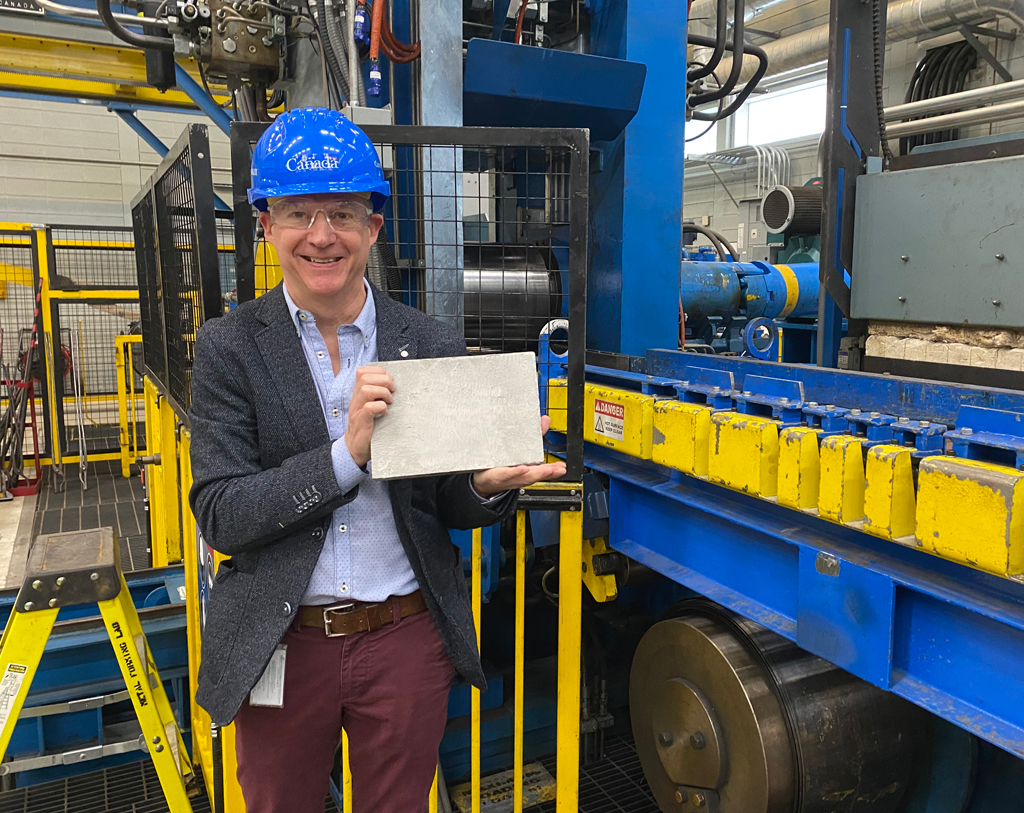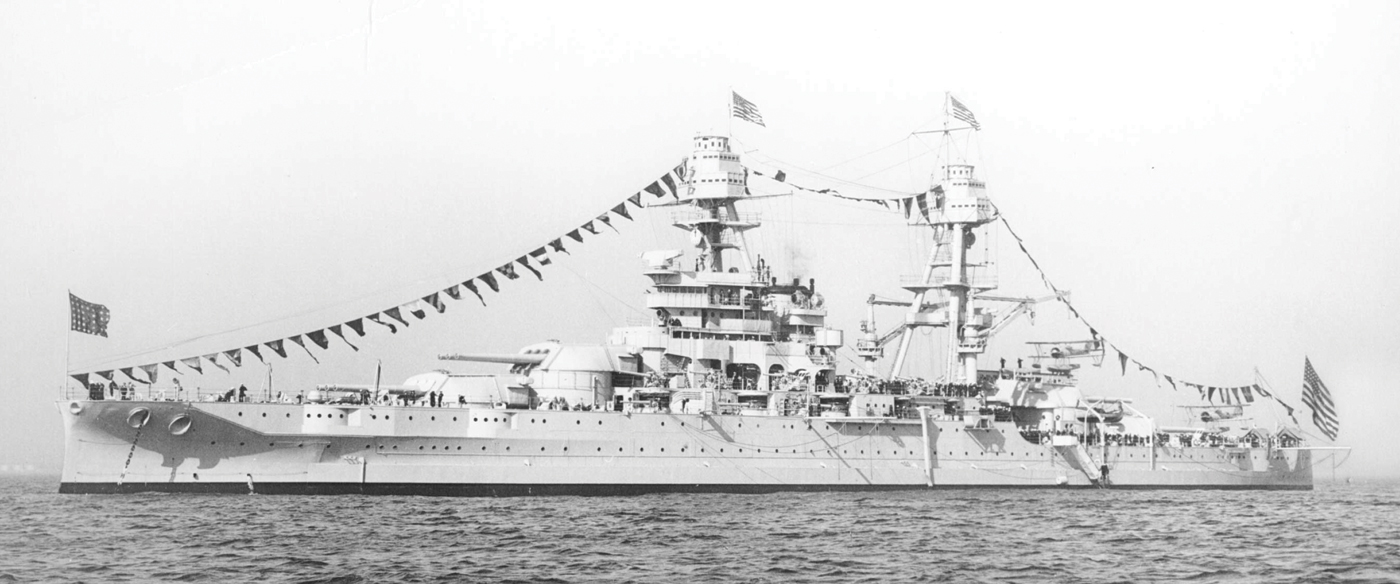Canadian lab aids special USS Arizona medal creation
By Lookout on Dec 13, 2021 with Comments 0
Philippe Dauphin, Director General of CanmetMATERIALS, holds a piece of steel ingot from the USS Arizona.
Peter Mallett
Staff Writer
––
Natural Resource Canada’s CanmetMATERIALS’ pilot-scale rolling mill was pressed into action Dec. 7 for an extraordinary task: to help complete the last run of the USS Arizona Medal of Freedom for the Lauren F. Bruner USS Arizona Memorial Foundation.
At precisely at 8:05 a.m. Hawaiian Standard Time the machine was switched on. The time and day were purposeful as it marked the precise moment 80 years ago when a single armor-piercing bomb hit at the heart of USS Arizona. It blew up its munitions magazine and fuel tanks, sinking the U.S. Navy Battleship and killing 1,177 of its 1,512 crew members. Eight USS Arizona crew members were Canadians with only one surviving.
“While the main focus of our lab is to develop solutions for Canadian industry, it is also important to take stock of historic events that happened before us,” says Philippe Dauphin, CMAT Director General. “The people who work in our laboratory are excited to have a connection to this horrific but important moment in history.”
CMAT is dedicated to the fabricating, processing, and evaluating of metals and materials. It’s scientific and technical staff at locations in Hamilton, and a satellite lab in Calgary, find answers and solutions for Canadian industry in the energy, transportation, and metal-manufacturing sectors.
Creating the medals
The Pilot Scale Rolling Mill is unique, says Dauphin, because it can accommodate testing of various metals in small sized runs and can be configured to roll hot steel at temperatures up to 1,200 degrees Celsius.
The metal ingots the mill is producing for the USS Arizona commemorative medals are steel salvaged from the ship’s superstructure after the attack.
Thermo mechanical processing uses several different hot and cold rolling steps to make the medals.
USS Arizona metal ingots will be heated in an oven to its maximum temperature, then taken from the oven and rolled on its Pilot Scale Rolling Mill. Seconds later they will be sprayed in cold water to quench the medal and preserve its metallic composition. In January, the ship’s steel will be rolled to a thickness of 1.6mm before they are sent back to the U.S. to complete the medals.
When the finished product is complete, the medal will include the ship’s name and a stylized letter ‘A’ on the top face, a ribbon, and pin bar.
In February, the medal will be offered for sale in Canada and the United States, says Ed McGrath, Executive Director of the Lauren F. Bruner USS Arizona Memorial Foundation. Proceeds from sales will be used to create hand-drawn portraits of each USS Arizona crew member and to fund the foundation’s educational programs, including an app for high school students in Canada and the United States.
Intriguing Request
The Lauren F. Bruner USS Arizona Memorial Foundation was established by Lauren F. Bruner, Fire Controlman Third Class and the second to last to leave USS Arizona following the attack.
He suffered burns to 73 per cent of his body when the battleship exploded and sank, and was wounded twice in his left leg from machine gun rounds fired by an attacking Japanese Zero. Throughout the rest of his life and prior to his death in 2019, Bruner worked tirelessly to preserve and educate people about the history of the attack and to support other survivors and their families.
A steel mill in Alabama was initially tasked with melting the steel extracted from Arizona to create the ingots. But it lacked a small-scale rolling mill to complete the job, especially affixing the stylized ‘A’ to the medal’s front. In mid-October, the Lauren F. Bruner USS Arizona Memorial Foundation sought out CMAT’s help to finish the project.
“I can’t say enough good things about Canada and all they have done for us, and what a relief it was to find someone who has the technology available and was willing to help us complete this job,” says McGrath.
A special Canadian edition of the medal will also be struck to commemorate the eight Canadians who served aboard the battleship when it was attacked.
“Their request was very intriguing and at first I wasn’t certain how we could justify doing this job, but the amount of interest it has generated in our facility by far exceeds our commitment to the project,” says Dauphin.
Interestingly, CMAT was established by the Government of Canada shortly after the attack on Pearl Harbor in 1942. Many of its projects were associated with Canada’s part in the final years of the war effort.
––
USS Arizona Canadian Crew Members on board Dec. 7, 1941
Roger J. Bergin – Killed In Action
(Moose Jaw, Saskatchewan)
Howard A. Bowman – Killed In Action
(Lang, Saskatchewan)
George W. Doherty – Killed In Action
(Saskatoon, Saskatchewan)
John Albert Doherty – Killed In Action
(Saskatoon, Saskatchewan)
Francis A. Ellis, Jr. – Killed In Action
(Winnipeg, Manitoba)
Anthony J. Hessdorfer – Killed In Action
(St. Benedict, Saskatchewan)
William F. Ross – Killed In Action
(Montreal, Quebec)
Guy D. Kirk – Survivor
(Ponoka, Alberta)
––––
Filed Under: Top Stories
About the Author:








